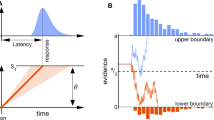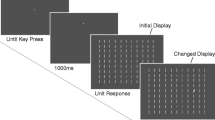Abstract
Eye movements provide a direct link to study the allocation of overt attention to stimuli in the visual field. The initiation of saccades towards visual stimuli is known to be influenced by the bottom-up salience of stimuli as well as the motivational context of the task. Here, we asked whether the initiation of saccades is also influenced by the intrinsic motivational salience of a stimulus. Face stimuli were first associated with positive or negative motivational salience through instrumental learning. The same faces served as target stimuli in a subsequent saccade task, in which their motivational salience was no longer task-relevant. Participants performed either voluntary saccades, which required the selection of the saccade target out of two simultaneously presented stimuli (experiment 1), or reactive saccades, where only the target stimulus was presented (experiment 2). We found a specific effect of learned positive stimulus value on the latencies of voluntary saccades: For faces with high versus low positive motivational salience, saccadic latencies were significantly reduced. No such difference was observed for previously punished faces. In contrast, reactive saccades to both previously rewarded and punished faces were unaffected by learned stimulus value. Our findings show for the first time that saccadic preparation is susceptible to the acquired intrinsic motivational salience of visual stimuli. Based on the observation that only voluntary saccades but not reactive saccades were modulated, we conclude that the recruitment of neural processes for target identification is required to allow for an influence of motivational stimulus salience on saccadic preparation.






Similar content being viewed by others
References
Anderson BA, Laurent PA, Yantis S (2011a) Value-driven attentional capture. Proc Natl Acad Sci USA 108:10367–10371
Anderson BA, Laurent PA, Yantis S (2011b) Learned value magnifies salience-based attentional capture. PLoS One 6:e27926
Armony JL, Dolan RJ (2002) Modulation of spatial attention by fear-conditioned stimuli: an event-related fMRI study. Neuropsychologia 40:817–826
Bannerman RL, Milders M, de Gelder B, Sahraie A (2009) Orienting to threat: faster localization of fearful facial expressions and body postures revealed by saccadic eye movements. Proc Biol Sci 276:1635–1641
Bannerman RL, Milders M, Sahraie A (2010) Attentional cueing: fearful body postures capture attention with saccades. J Vis 10:23
Belova MA, Paton JJ, Salzman CD (2008) Moment-to-moment tracking of state value in the amygdala. J Neurosci 28:10023–10030
Berridge KC, Robinson TE (1998) What is the role of dopamine in reward: hedonic impact, reward learning, or incentive salience? Brain Res Brain Res Rev 28:309–369
Bisley JW, Goldberg ME (2010) Attention, intention, and priority in the parietal lobe. Annu Rev Neurosci 33:1–21
Blaukopf CL, DiGirolamo DJ (2006) Differential effects of reward and punishment on conscious and unconscious eye movements. Exp Brain Res 174:786–792
Bonifacci P, Ricciardelli P, Lugli L, Pellicano A (2008) Emotional attention: effects of emotion and gaze direction on overt orienting of visual attention. Cogn Process 9:127–135
Cornelissen FW, Kimmig H, Schira M, Rutschmann RM, Maguire RP, Broerse A, Den Boer JA, Greenlee MW (2002) Event-related fMRI responses in the human frontal eye fields in a randomized pro- and antisaccade task. Exp Brain Res 145:270–274
Cousineau D (2005) Confidence intervals in within-subject designs: a simpler solution to Loftus and Masson’s method. Tutor Quant Methods Psychol 1:42–45
Crouzet SM, Kirchner H, Thorpe SJ (2010) Fast saccades toward faces: face detection in just 100 ms. J Vis 10:1–17
Curtis CE, Connolly JD (2008) Saccade preparation signals in the human frontal and parietal cortices. J Neurophysiol 99:133–145
De Haan B, Morgan PS, Rorden C (2008) Covert orienting of attention and overt eye movements activate identical brain regions. Brain Res 1204:102–111
Della Libera C, Chelazzi L (2006) Visual selective attention and the effects of monetary rewards. Psychol Sci 17:222–227
Della Libera C, Chelazzi L (2009) Learning to attend and to ignore is a matter of gains and losses. Psychol Sci 20:778–784
Della Libera C, Perlato A, Chelazzi L (2011) Dissociable effects of reward on attentional learning: from passive associations to active monitoring. PLoS One 6:e19460
Desimone R, Duncan J (1995) Neural mechanisms of selective visual attention. Annu Rev Neurosci 18:193–222
DeSouza JFX, Menon RS, Everling S (2003) Preparatory set associated with pro-saccades and anti-saccades in humans investigated with event-related FMRI. J Neurophysiol 89:1016–1023
Dorris MC, Paré M, Munoz DP (1997) Neuronal activity in monkey superior colliculus related to the initiation of saccadic eye movements. J Neurosci 17:8566–8579
Freedman DJ, Assad JA (2006) Experience-dependent representation of visual categories in parietal cortex. Nature 443:85–88
Geyer T, Müller HJ, Krummenacher J (2008) Expectancies modulate attentional capture by salient color singletons. Vision Res 48:1315–1326
Gottlieb J (2007) From thought to action: the parietal cortex as a bridge between perception, action, and cognition. Neuron 53:9–16
Harris A, Adolphs R, Camerer C, Rangel A (2011) Dynamic construction of stimulus values in the ventromedial prefrontal cortex. PLoS ONE 6:e21074
Hickey C, van Zoest W (2012) Reward creates oculomotor salience. Curr Biol 22:R19–R20
Hickey C, Chelazzi L, Theeuwes J (2010a) Reward changes salience in human vision via the anterior cingulate. J Neurosci 30:11096–11103
Hickey C, Chelazzi L, Theeuwes J (2010b) Reward guides vision when it’s your thing: trait reward-seeking in reward-mediated visual priming. PLoS One 5:e14087
Hong S, Hikosaka O (2011) Dopamine-mediated learning and switching in cortico-striatal circuit explain behavioral changes in reinforcement learning. Front Behav Neurosci 5:15
Hunt AR, von Mühlenen A, Kingstone A (2007) The time course of attentional and oculomotor capture reveals a common cause. J Exp Psychol Hum Percept Perform 33:271–284
Itti L, Koch C (2000) A saliency-based search mechanism for overt and covert shifts of visual attention. Vision Res 40:1489–1506
Itti L, Koch C (2001) Computational modelling of visual attention. Nat Rev Neurosci 2:194–203
Jazbec S, Hardin MG, Schroth E, McClure E, Pine DS, Ernst M (2006) Age-related influence of contingencies on a saccade task. Exp Brain Res 174:754–762
Kahnt T, Heinzle J, Park SQ, Haynes J-D (2011) Decoding different roles for vmPFC and dlPFC in multi-attribute decision making. Neuroimage 56:709–715
Kowler E, Anderson E, Dosher B, Blaser E (1995) The role of attention in the programming of saccades. Vision Res 35:1897–1916
Ludwig CJH, Gilchrist ID, McSorley E (2004) The influence of spatial frequency and contrast on saccade latencies. Vision Res 44:2597–2604
Madelain L, Paeye C, Darcheville J-C (2011) Operant control of human eye movements. Behav Process 87:142–148
Marino RA, Munoz DP (2009) The effects of bottom-up target luminance and top-down spatial target predictability on saccadic reaction times. Exp Brain Res 197:321–335
McSorley E, Haggard P, Walker R (2006) Time course of oculomotor inhibition revealed by saccade trajectory modulation. J Neurophysiol 96:1420–1424
Medendorp WP, Buchholz VN, Van Der Werf J, Leoné FTM (2011) Parietofrontal circuits in goal-oriented behaviour. Eur J Neurosci 33:2017–2027
Milstein DM, Dorris MC (2007) The influence of expected value on saccadic preparation. J Neurosci 27:4810–4818
Moher J, Abrams J, Egeth HE, Yantis S, Stuphorn V (2011) Trial-by-trial adjustments of top-down set modulate oculomotor capture. Psychon Bull Rev 18:897–903
Montagnini A, Chelazzi L (2005) The urgency to look: prompt saccades to the benefit of perception. Vision Res 45:3391–3401
Morand SM, Grosbras M-H, Caldara R, Harvey M (2010) Looking away from faces: influence of high-level visual processes on saccade programming. J Vis 10(16):1–10
Myers KM, Davis M (2002) Behavioral and neural analysis of extinction. Neuron 36:567–584
Nummenmaa L, Hyönä J, Calvo MG (2009) Emotional scene content drives the saccade generation system reflexively. J Exp Psychol Hum Percept Perform 35:305–323
O’Doherty J, Dayan P, Schultz J, Deichmann R, Friston K, Dolan RJ (2004) Dissociable roles of ventral and dorsal striatum in instrumental conditioning. Science 304:452–454
Paré M, Munoz DP (1996) Saccadic reaction time in the monkey: advanced preparation of oculomotor programs is primarily responsible for express saccade occurrence. J Neurophysiol 76:3666–3681
Paton JJ, Belova MA, Morrison SE, Salzman CD (2006) The primate amygdala represents the positive and negative value of visual stimuli during learning. Nature 439:865–870
Pessiglione M, Seymour B, Flandin G, Dolan RJ, Frith CD (2006) Dopamine-dependent prediction errors underpin reward-seeking behaviour in humans. Nature 442:1042–1045
Pizzagalli DA, Lehmann D, Hendrick AM, Regard M, Pascual-Marqui RD, Davidson RJ (2002) Affective judgments of faces modulate early activity (approximately 160 ms) within the fusiform gyri. Neuroimage 16:663–677
Ptak R (2012) The frontoparietal attention network of the human brain: action, saliency, and a priority map of the environment. Neuroscientist 18:502–515
Ratcliff R (1979) Group reaction time distributions and an analysis of distribution statistics. Psychol Bull 86:446–461
Raymond JE, O’Brien JL (2009) Selective visual attention and motivation: the consequences of value learning in an attentional blink task. Psychol Sci 20:981–988
Redgrave P, Coizet V, Comoli E, McHaffie JG, Leriche M, Vautrelle N, Hayes LM, Overton P (2010) Interactions between the midbrain superior colliculus and the basal ganglia. Front Neuroanat 4:132
Rolfs M, Vitu F (2007) On the limited role of target onset in the gap task: support for the motor-preparation hypothesis. J Vis 7:1–20
Rolls ET (2007) The representation of information about faces in the temporal and frontal lobes. Neuropsychologia 45:124–143
Ross M, Lanyon LJ, Viswanathan J, Manoach DS, Barton JJ (2011) Human prosaccades and antisaccades under risk: effects of penalties and rewards on visual selection and the value of actions. Neuroscience 196:168–177
Rutherford HJV, O’Brien JL, Raymond JE (2010) Value associations of irrelevant stimuli modify rapid visual orienting. Psychon Bull Rev 17:536–542
Rutishauser U, Koch C (2007) Probabilistic modeling of eye movement data during conjunction search via feature-based attention. J Vis 7:5
Saslow MG (1967) Effects of components of displacement-step stimuli upon latency for saccadic eye movement. J Opt Soc Am 57:1024–1029
Soto D, Heinke D, Humphreys GW, Blanco MJ (2005) Early, involuntary top-down guidance of attention from working memory. J Exp Psychol Hum Percept Perform 31:248–261
Sparks DL (2002) The brainstem control of saccadic eye movements. Nat Rev Neurosci 3:952–964
Sugrue LP, Corrado GS, Newsome WT (2004) Matching behavior and the representation of value in the parietal cortex. Science 304:1782–1787
Theeuwes J (1992) Perceptual selectivity for color and form. Percept Psychophys 51:599–606
Theeuwes J, Kramer AF, Hahn S, Irwin DE (1998) Our eyes do not always go where we want them to go: capture of the eyes by new objects. Psychol Sci 9:379–385
Theeuwes J, Kramer AF, Hahn S, Irwin DE, Zelinsky GJ (1999) Influence of attentional capture on oculomotor control. J Exp Psychol Hum Percept Perform 25:1595–1608
Tottenham N, Tanaka JW, Leon AC, McCarry T, Nurse M, Hare TA, Marcus DJ, Westerlund A, Casey BJ, Nelson C (2009) The NimStim set of facial expressions: judgments from untrained research participants. Psychiatry Res 168:242–249
Tovée MJ, Rolls ET, Treves A, Bellis RP (1993) Information encoding and the responses of single neurons in the primate temporal visual cortex. J Neurophysiol 70:640–654
Trappenberg TP, Dorris MC, Munoz DP, Klein RM (2001) A model of saccade initiation based on the competitive integration of exogenous and endogenous signals in the superior colliculus. J Cogn Neurosci 13:256–271
Valentin VV, Dickinson A, O’Doherty JP (2007) Determining the neural substrates of goal-directed learning in the human brain. J Neurosci 27:4019–4026
Van Gisbergen JA, Van Opstal AJ, Tax AA (1987) Collicular ensemble coding of saccades based on vector summation. Neuroscience 21:541–555
van Zoest W, Donk M (2010) Awareness of the saccade goal in oculomotor selection: your eyes go before you know. Conscious Cogn 19:861–871
Wong JH, Peterson MS (2011) The interaction between memorized objects and abrupt onsets in oculomotor capture. Atten Percept Psychophys 73:1768–1779
Xu-Wilson M, Zee DS, Shadmehr R (2009) The intrinsic value of visual information affects saccade velocities. Exp Brain Res 196:475–481
Yacubian J, Gläscher J, Schroeder K, Sommer T, Braus DF, Büchel C (2006) Dissociable systems for gain- and loss-related value predictions and errors of prediction in the human brain. J Neurosci 26:9530–9537
Acknowledgments
This study was supported by the German Research Foundation (Emmy-Noether Programme, STE 1430/2-1).
Author information
Authors and Affiliations
Corresponding author
Rights and permissions
About this article
Cite this article
Rothkirch, M., Ostendorf, F., Sax, AL. et al. The influence of motivational salience on saccade latencies. Exp Brain Res 224, 35–47 (2013). https://doi.org/10.1007/s00221-012-3284-4
Received:
Accepted:
Published:
Issue Date:
DOI: https://doi.org/10.1007/s00221-012-3284-4




